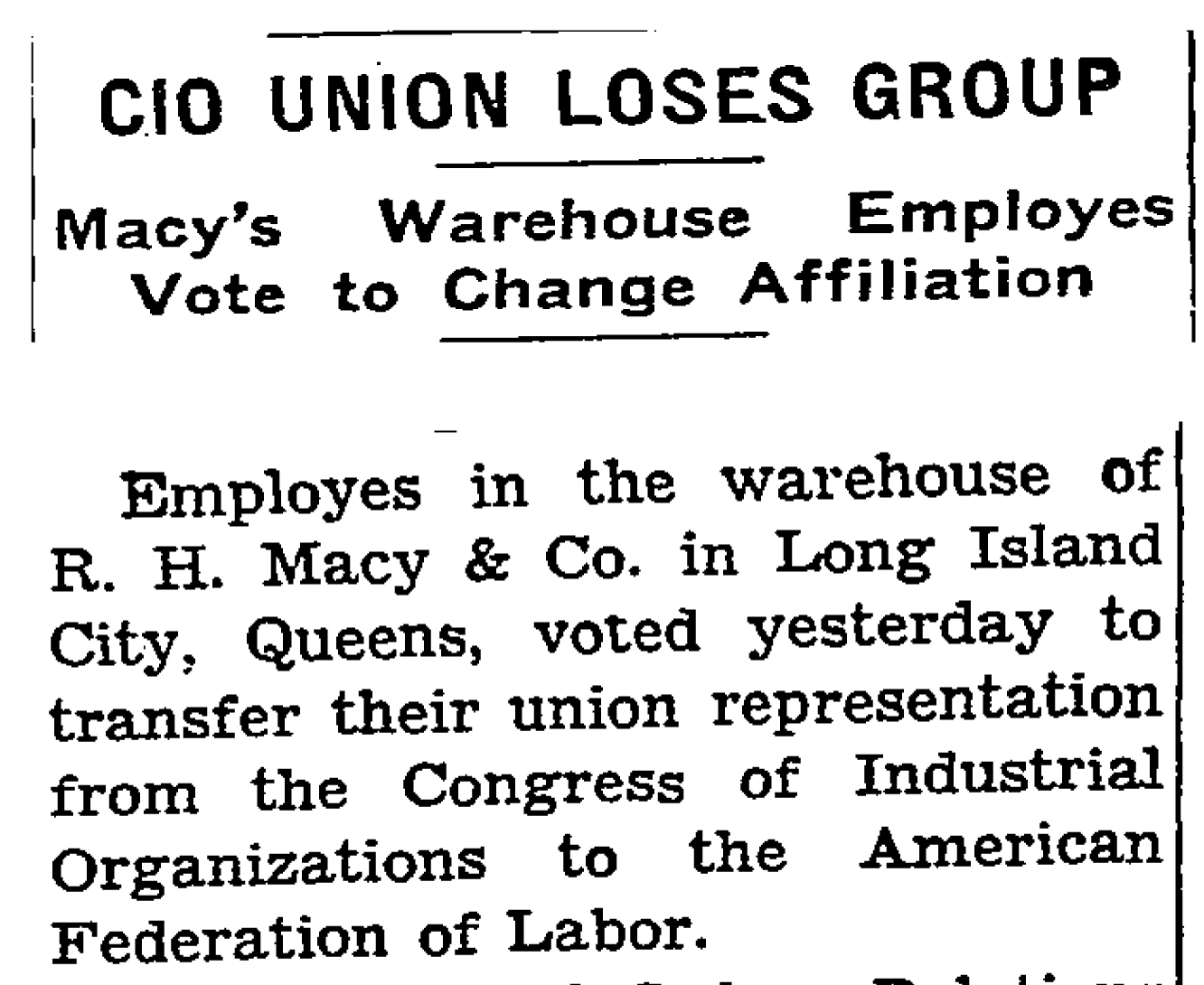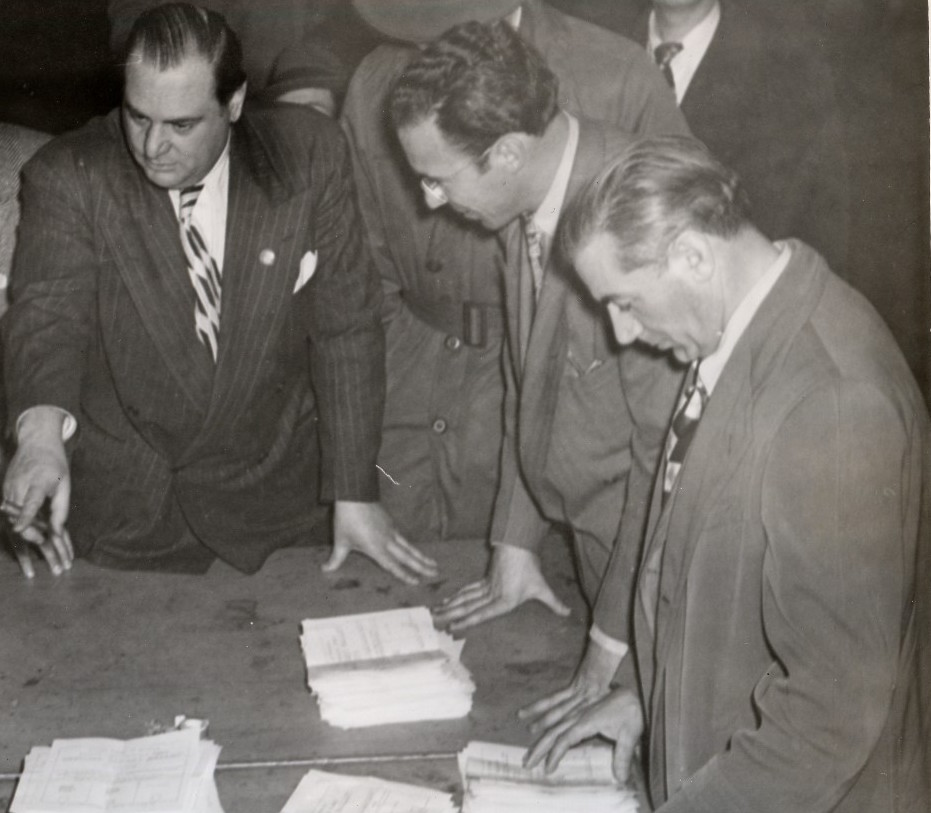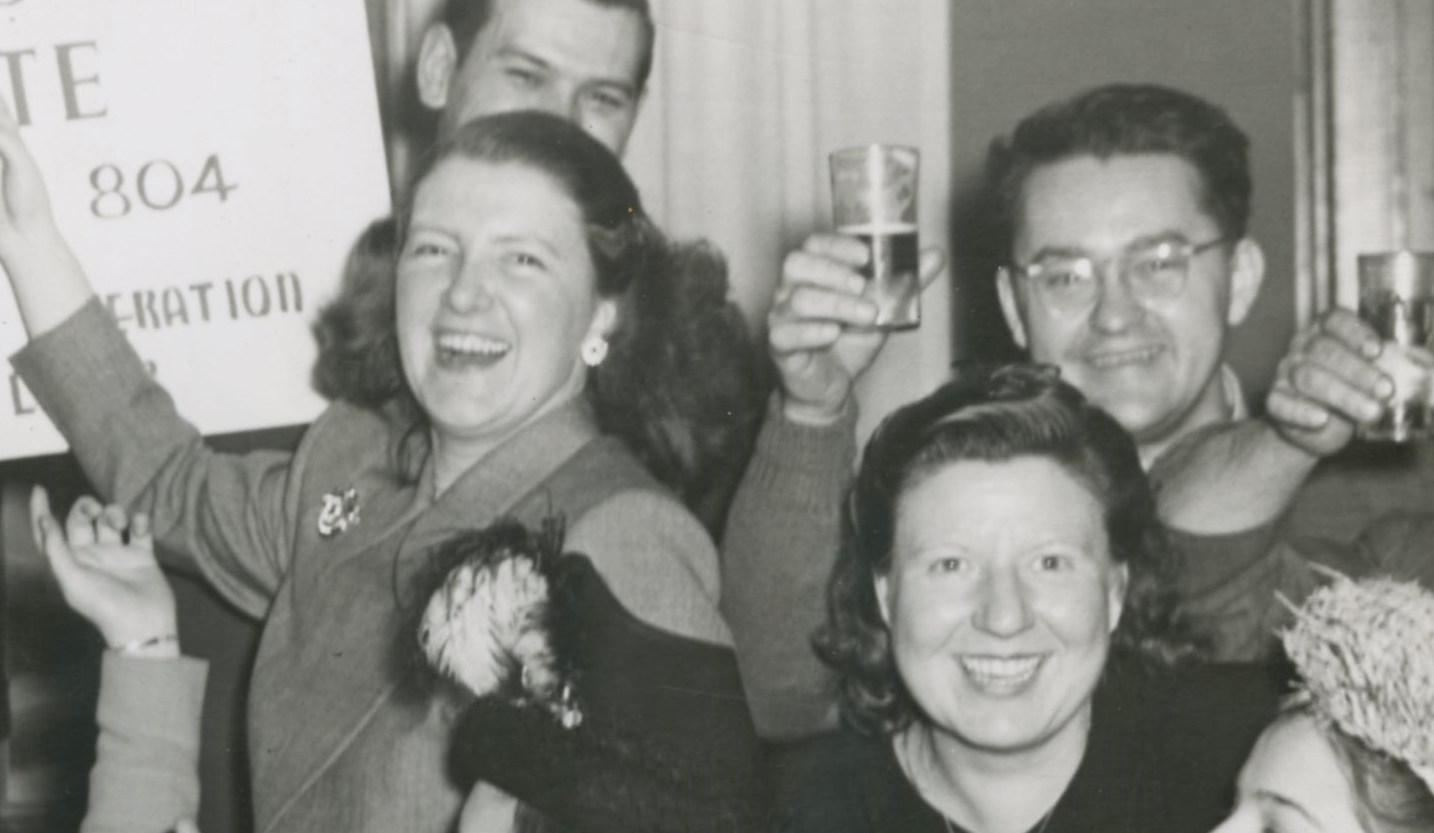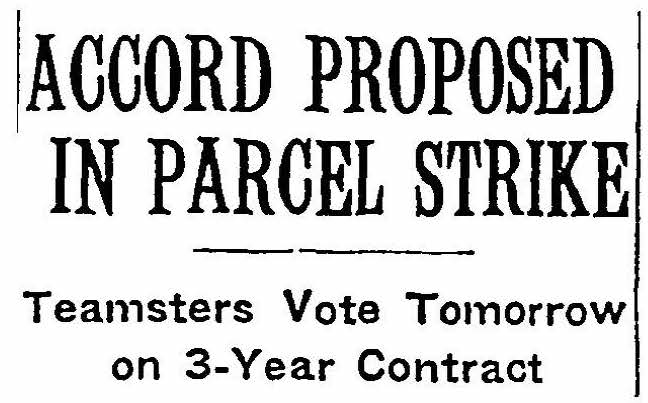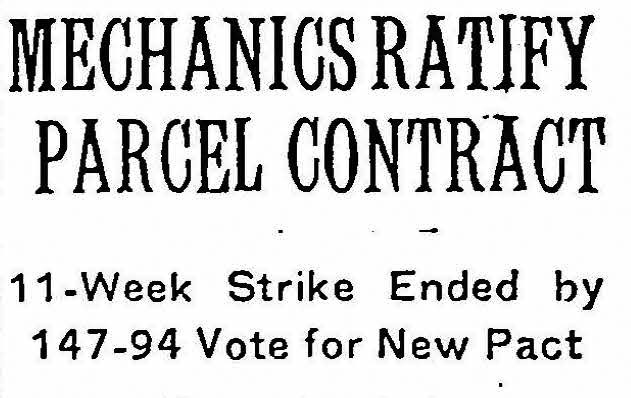It is said that “you can’t know where you’re going if you don’t know where you’ve been.” Since our founding, Local 804 members have fought for better wages, benefits and working conditions. Local 804 members deserve to be proud of all our union has accomplished over the years. Just as we are grateful for the struggles of our union brothers and sisters that preceded us, so must we keep up the fight to ensure a good future for the next generation of Local 804 members.
Part 1 – A Strong Union is Born (1937-1940)
Local 804 was formed in the depths of the Great Depression, during a period of great labor strife and activism. Our first charter, granted by the International Brotherhood of Teamsters in 1937, gave the union jurisdiction of UPS delivery drivers, as the company was expanding its operations to New York and the east coast.
A year after Local 804 was chartered, there was an all-out Teamsters strike New York City. Truck drivers effectively blockaded the city as union members fought for, and won, a 44-hour workweek.
Congress soon passed the Motor Carrier Safety Act of 1938, providing health and safety protections for truck drivers. The law guaranteed drivers the right to have an eight hour break after working for ten hours in a 24-hour period and a maximum of 60 hours behind the wheel each week.
| Click on images to enlarge | ||
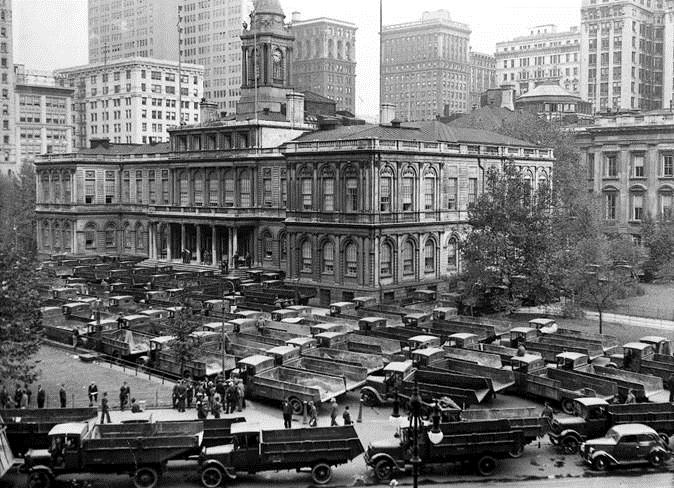 |
 |
|
| 1938 NYC truck strike |
An early charter |
The following year, 1939, Local 804 engaged in its first strike against UPS. Workers protested the suspension of a member in violation of the grievance procedure. The strike was effective; the workers returned to the job and an arbitration was scheduled. This spirit of justice and militancy has remained the hallmark of Local 804 throughout the decades.
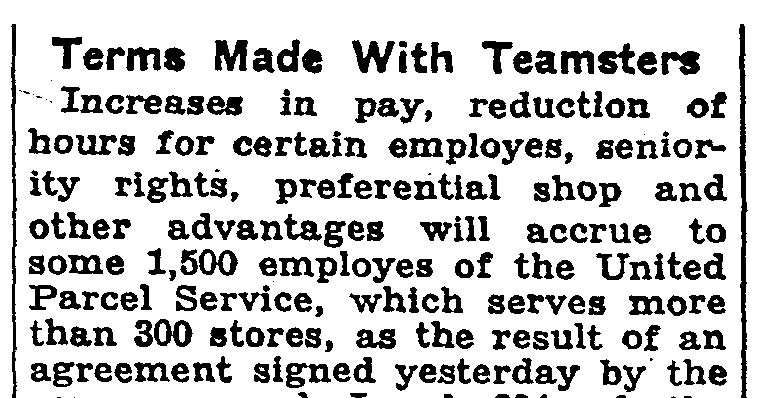 |
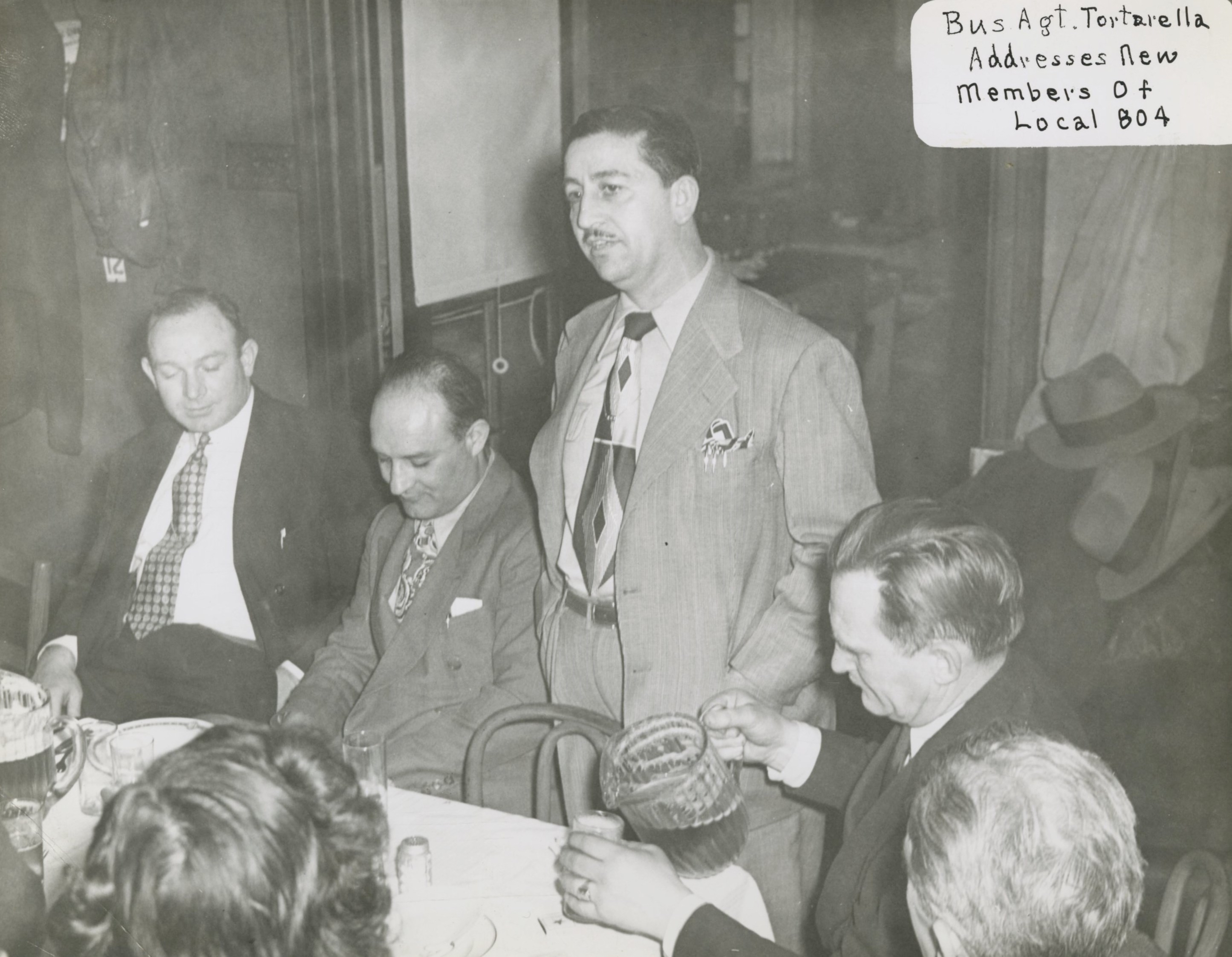 |
|
| Local 804's first contract |
Joseph Tortorella, center, |
Early 804 members primarily delivered packages from department stores to customers’ homes. Until the 1930’s, most large stores had their own delivery departments, but during the depression they began to contract this work out to UPS in order to save money. As UPS expanded in New York City, so did Local 804. By 1940, the union had 1,800 members.
It was also at this time that the union decided that to increase its power it must expand and actively organize new workers. The Merchandise Delivery Drivers and Employees union expanded its jurisdiction beyond UPS and in the 1940’s aggressively organized department store and trucking employees.
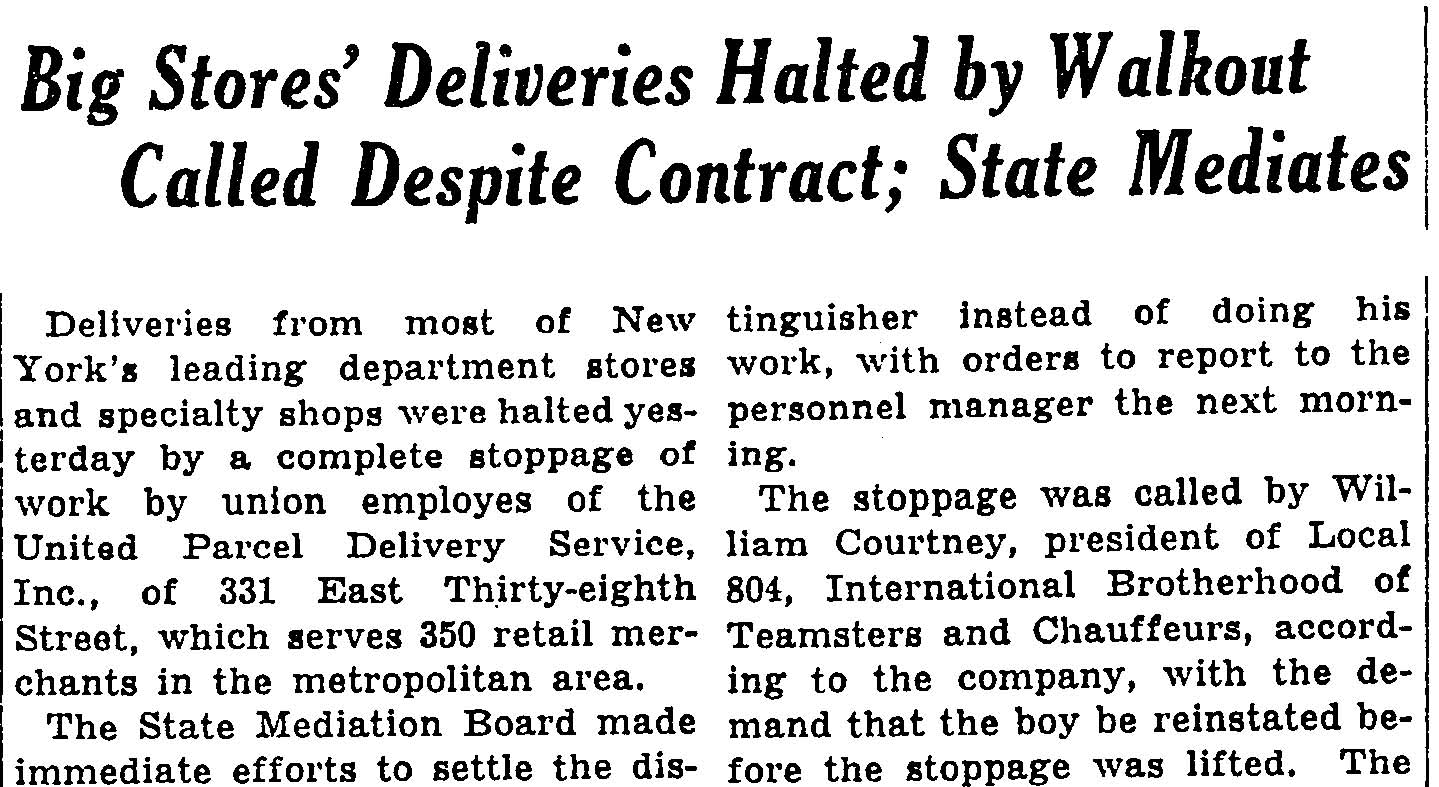 |
| 1939 walkout |
Part 2 – World War 2
Local 804 members have a reputation for both patriotism and union solidarity. From its inception, Local 804 understood the importance of supporting other workers’ struggles and working with other unions to achieve common goals. Area Teamster Locals representing UPS workers including New Jersey Locals 138 and 177 and New York Local 804, 478 and138 bargained together. In December of 1941, Local 804 had 3,325 members.
And when their country needed them, Local 804 members heeded the call.
The US declared war on Japan and Germany in December1941. Local 804 members did their part on the battlefield and on the home front. More than 500 active Local 804 members served in the military during the Second World War. The majority of them returned to their union jobs.
After the U.S. entrance into World War II, with many UPS workers joining the armed forces, UPS began to hire women to work in the operations side of the company. By December 1942, UPS employed women in the operations of its major cities. The women still worked behind the scenes, in jobs such as sorting, tracing, routing, and loading of packages. A year later, women were hired as drivers as well.
Both major labor federations, the American Federation of Labor (AFL) and the Congress of Industrial Organizations (CIO), and their affiliated unions, including the Teamsters, promised “no-strike” pledges for the duration of the war. At President Roosevelt’s urging, union leaders agreed to temporarily set aside differences with management to ensure no disruptions in wartime production. But, business leaders rarely permitted the war to come between them and profits. Seizing a chance to cut company costs, NYC area department stores placed ads in local papers urging their customers to carry their own packages home as a way of contributing to the war effort.
In return for labor's no-strike pledge, the government offered arbitration to determine the wages and other terms of new contracts. Those procedures produced modest wage increases during the first few years of the war but didn’t keep up with inflation, particularly when combined with the lengthy arbitration process. Additionally, some businesses took advantage of the wartime rules to reduce labor costs and generally take advantage of workers.
While union members overwhelming supported the war effort, the no-strike pledge caused tensions and difficulties for workers. Union officials, for the most part, stood by their pledge and refused to sanction strikes and walkouts. As a result, most worker actions were described as “wildcat”, or illegal under union rules.
| Click on images to enlarge | ||
 |
 |
|
|
New York City's Mayor was instrumental in settling a 1942 UPS strike. |
A 1945 telegram to IBT Pres. Tobin, explaining a stoppage in violation of the no-strike pledge |
Despite the no-strike pledge, Local 804 members struck UPS in June 1942, stopping the deliveries of 100,000 packages at 375 stores in the New York metropolitan area. Following the suspension of 315 drivers for refusal to do overtime, the strike began at the beginning of June. Wage increases and jurisdictional disputes with other local unions were also at issue. Two and a half weeks later, Mayor LaGuardia intervened, and a contract was reached.
Until the war ended in 1945, Local 804 was involved in several more disputes, either on behalf of Local 804 members or in support of other union members. Servicemen returned home, and labor unions were no longer bound by wartime rules.
Before the war most groceries, dry cleaners, drugstores, and department stores offered local home delivery service. During the war, the labor shortage as well as gasoline and tire rationing, gave retailers a reason to limit or stop delivery services. They found that requiring customers to buy their products in person increased sales. This reduced UPS business, and with 804 members returning from war to their old jobs, the union worried about layoffs and unemployment.
To counter job loss, Local 804 launched a public relations campaign to encourage shoppers to return to their pre-war consumer habits. At the end of the war, Local 804 membership was down to 1,900. The union ran an ad in NYC area papers urging women to “not be imposed upon” and made the case that shoppers were paying for delivery whether or not they carried their own packages and that 800 experienced men needed the work. The post war economic boom, as it turned out, also helped to alleviate the jobs shortage.
| Click on images to enlarge | ||
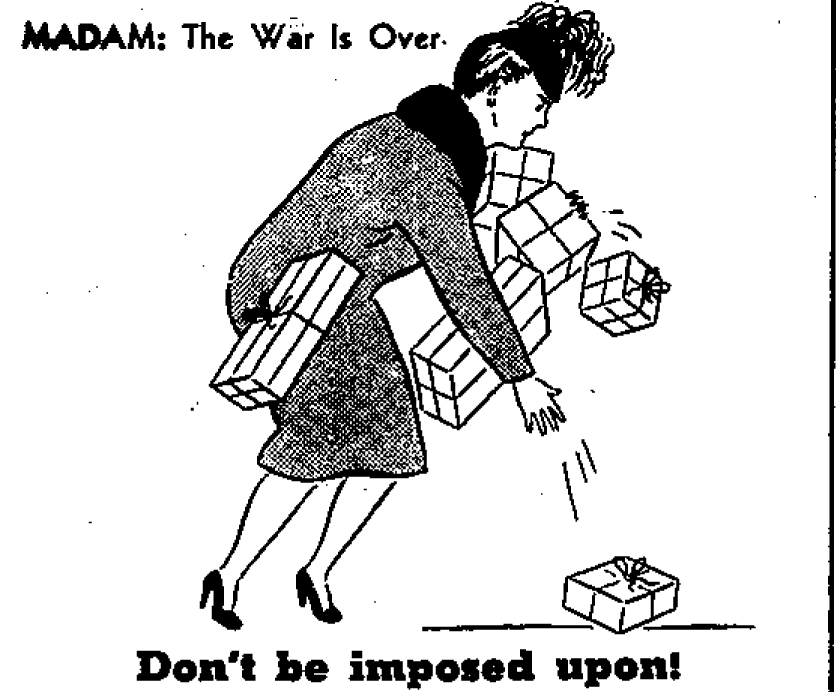 |
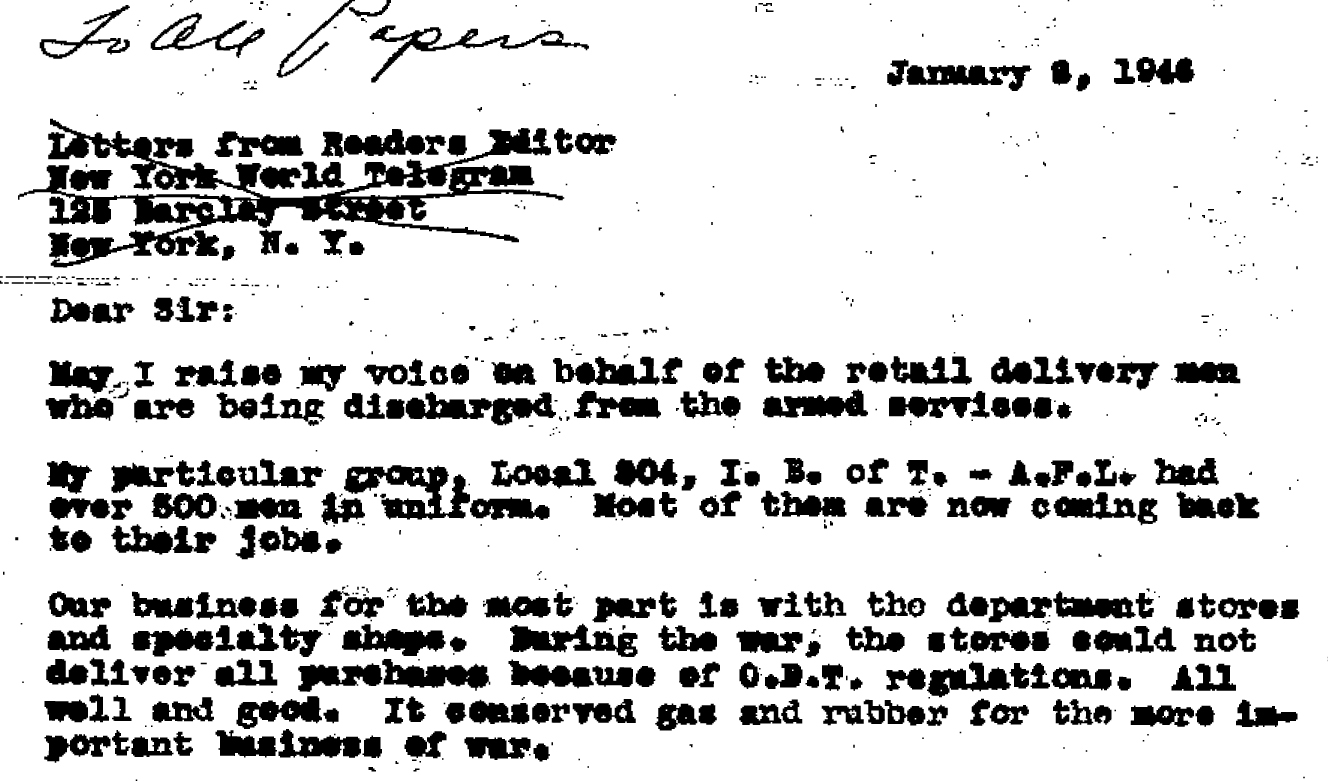 |
|
|
Detail from an ad Local 804 ran to encourage shoppers to use home delivery |
A 1946 letter to newspapers making the case that returning vets need delivery jobs |
Then, as now, the union understood that in order increase its bargaining power, it had to grow. Organizing new members provided the union the density needed to strengthen the union. The International union helped the Local to aggressively organize in the following years.
Part 3 – Labor and The Cold War
After the war, AFL and CIO affiliated unions competed bitterly for new membership. Many Teamster gains, as members of the AFL, came at the expense of CIO unions, which were linked to leftwing political and communist leanings. The bulk of Local 804’s newly organized warehouse and store delivery members had formerly belonged to CIO unions, such as the Retail, Warehouse, and Department Store Union (RWDSU).
Macy’s sold its delivery service to UPS in 1946. With the sale, Macy’s 800 drivers and helpers became Local 804 members. Leonard Geiger, a Macy worker and RWDSU Local 1 union official, led a 10-day strike against Macy’s to oppose the store’s decision to turn Macy deliveries over to UPS. The company made concessions, and Geiger was given a union position at Local 804. Two years later, he led Local 804’s successful effort to have Macy warehouse workers vote for IBT representation. Geiger went on to be elected President of the Local in 1949.
| Click on images to enlarge | ||
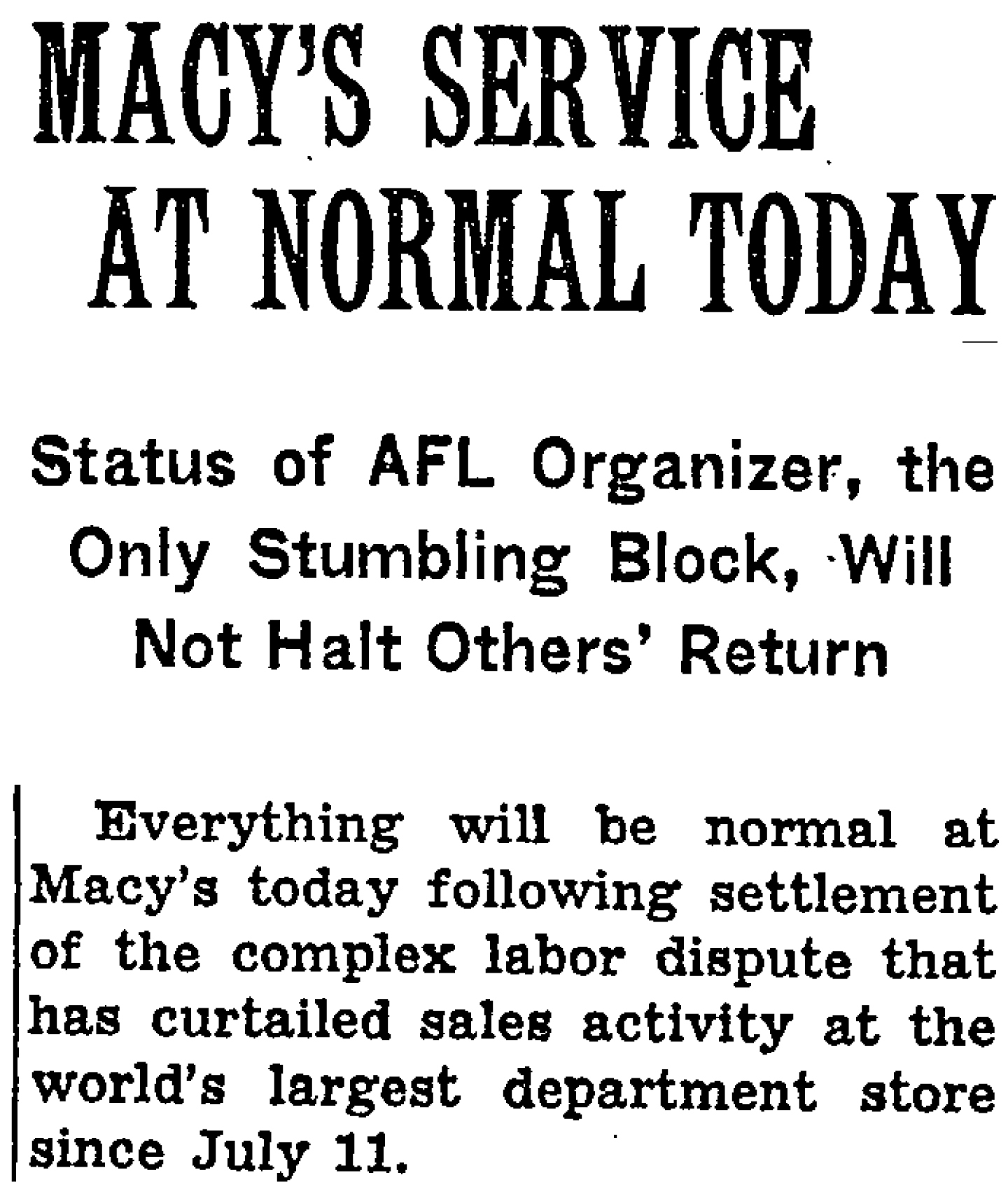 |
 |
|
|
RWDSU Local 1 Macy's Drivers struck when the company sold deliver services to UPS. |
Macy's Driver Leonard Geiger went on to become a Local 804 organizer and President. |
With a recession and the advent of the cold war, Republicans won control of the Congress in the 1946 elections.The Republican Party immediately went after the base of the Democratic Party - labor unions. In 1947 they passed the Taft-Hartley Act. It prohibited jurisdictional strikes, secondary boycotts and "common site" picketing, closed shops, and monetary donations by unions to federal political campaigns. Congress overrode President Truman's veto on June 23.
Taft-Hartley required all union officers to sign a non-communist affidavit. Unions whose officers did not file the affidavits could not use the services of the NLRB. They could not be officially certified as bargaining agents or obtain union shop agreements; nor could the NLRB process their unfair labor practice complaints or let them participate in representation elections.
A number of CIO local unions representing NYC area store employees had leaders who refused to file a non-communist affidavit. Because of these Taft-Harley violations, the incumbent union could not legally be listed on an election ballet. This gave Local 804 an additional advantage in representational elections.
While both labor groups spent considerable resources fighting one another, the real enemies, as today, were the political and corporate powers that fought to suppress workers’ rights. In 1947, Local members were arrested for leafleting outside of Bloomingdales while appealing to customers to have goods delivered. Their charges? Violating the sanitation code by creating litter.
Area UPS workers struck again in 1946 for fifty days. The decision to strike caused a rift in Local 804’s leadership. Local President Tortorella and Organizer Leonard Geiger supported the strike, while the majority of the Executive Board opposed it. Without an affirmative vote of the Board, the International declared the action illegal. The inter-local feud became so bitter that Tortorella “seized the union office” in the midst of the strike.
| Click on images to enlarge | ||
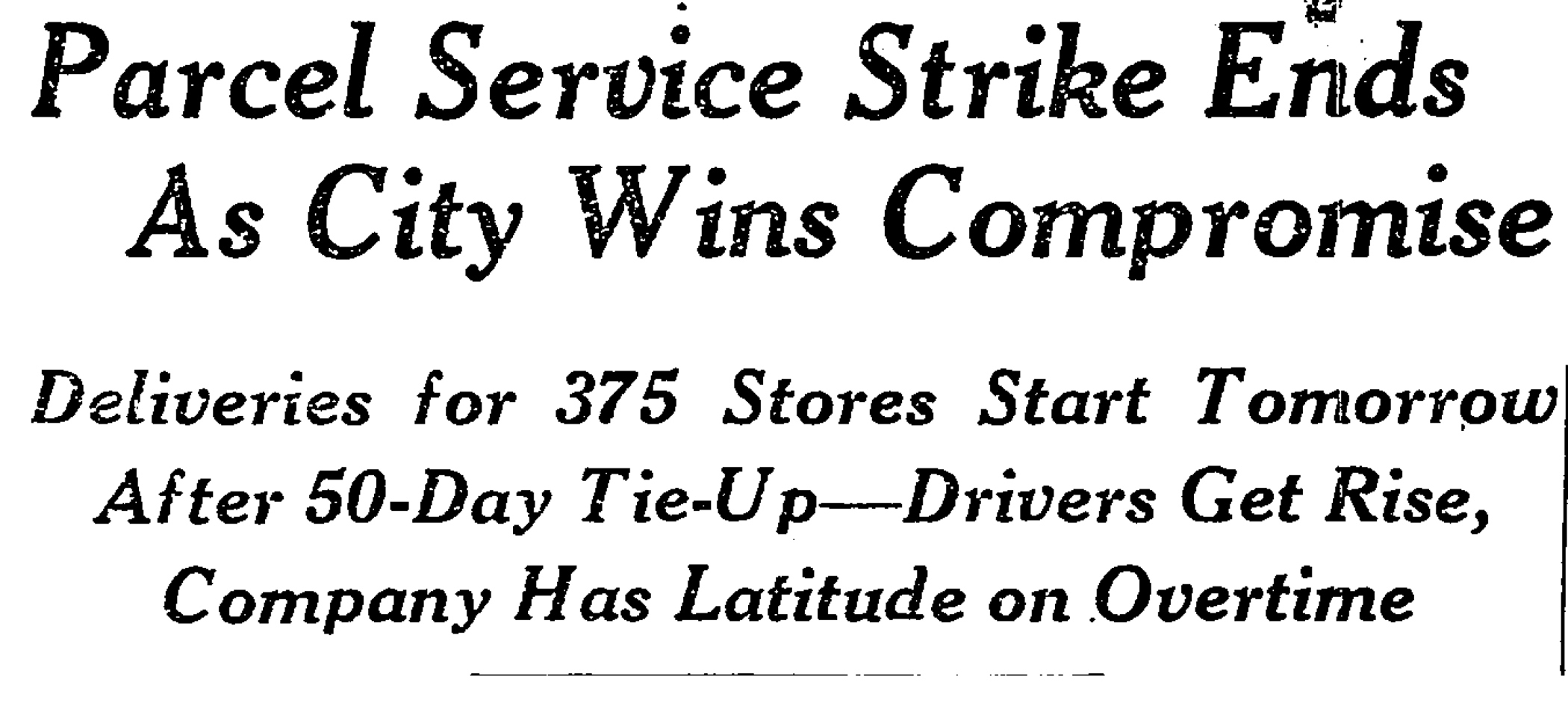 |
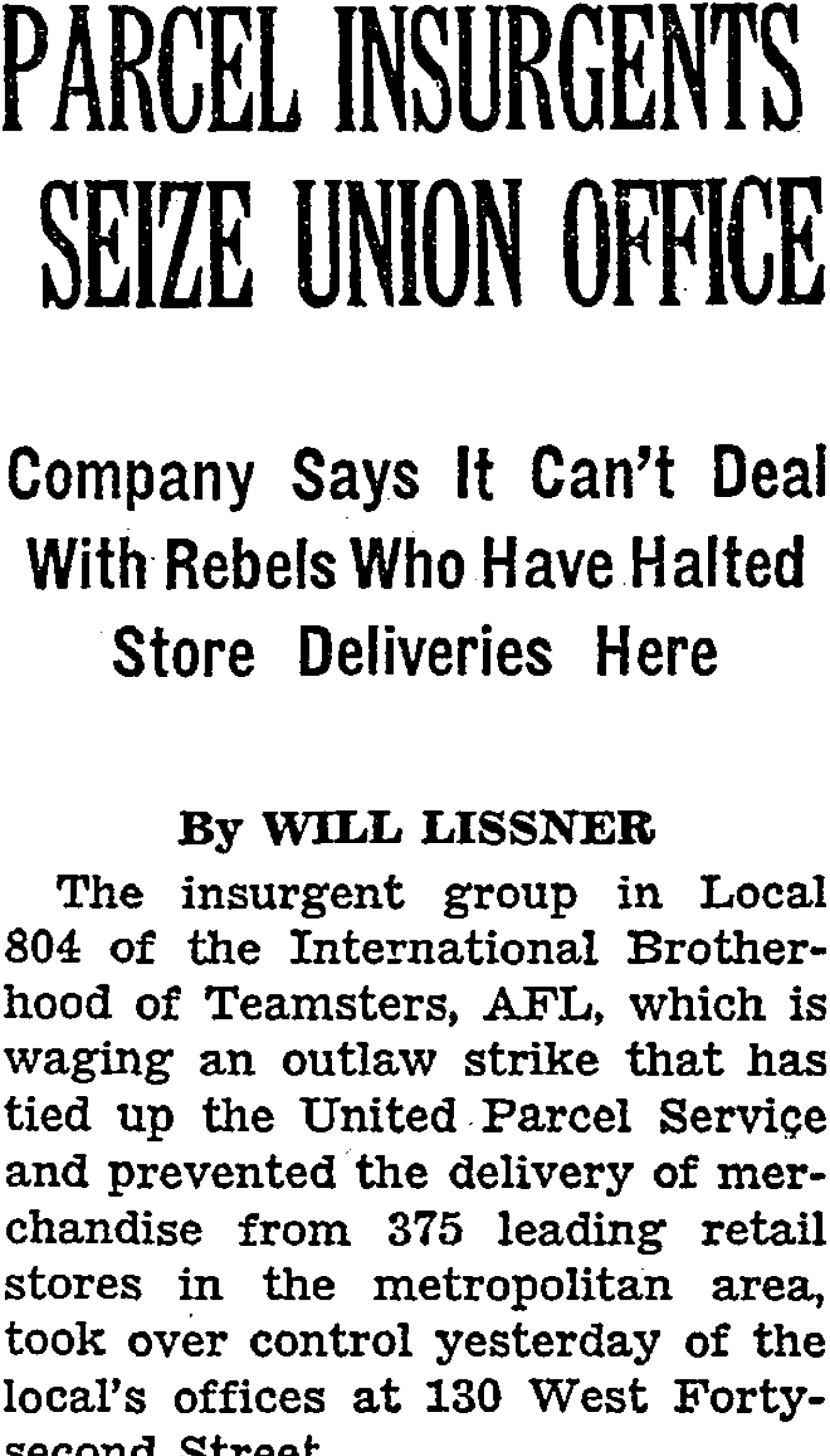 |
|
|
Local 804 members participated in an unsanctioned strike in 1946. |
The strike led to a bitter split of the Executive Board. |
Drivers won a 33.5 cent hourly raise, a 40-hour workweek and night differentials. However they did not make progress on one of their primary issues – an end to excessive overtime. A month later, President Tortorella retired and members elected a new slate of Local Officers headed by President Edward Conway.
Area Teamster locals continued organizing. An April 1948 joint organizing campaign between Teamsters Locals 138, 177, 478 and 804 for UPS warehouse workers resulted in a 2832 to 16 vote in favor of Teamster representation. In May of 1948, Leonard Geiger headed the successful campaign to represent Macy warehouse workers.
Not all of Local 804’s campaigns were initially successful. In June 1948, Local 804 attempted to organize Woolworth Warehouse – basically raiding Wholesale and Warehouse workers Union, Local 65, CIO. Local 65 didn’t comply with the anti-communist provisions of the NLRB Act of 1947 and couldn’t appear on the ballot of the NLRB election. Yet Local 804 lost the election 146 – 155, with a bare majority voting for no union.
In 1949, the Local was granted a new charter. Local 804 was then known, as it is today, as Delivery and Warehouse Workers, Local Number 804. The local had grown to 10,000 members. Local 804 received a boost when IBT launched a major national organizing campaign of all store workers, with the exception of clerks, with a coordinated effort in the New York metropolitan area.
| Click on images to enlarge | ||
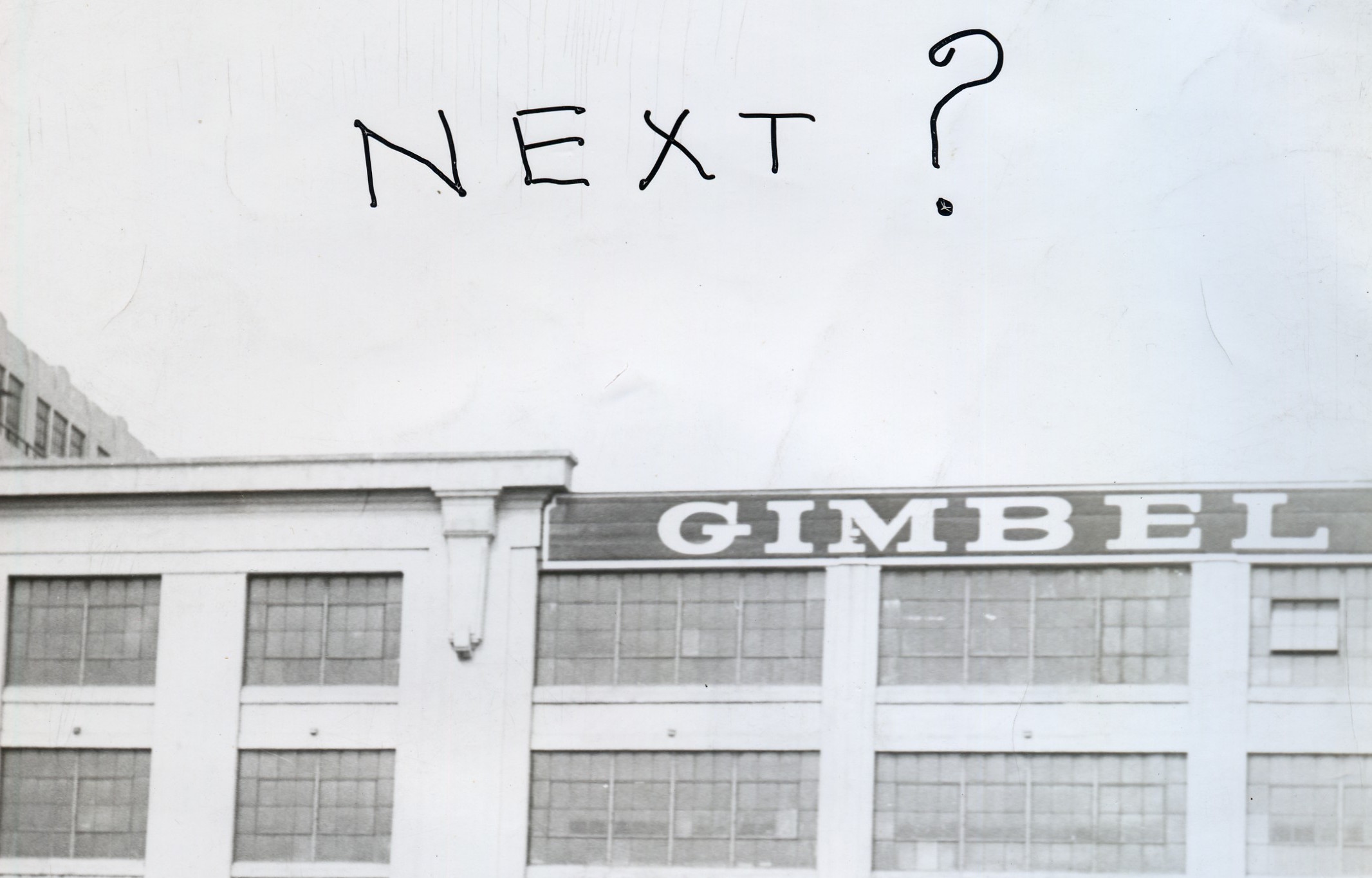 |
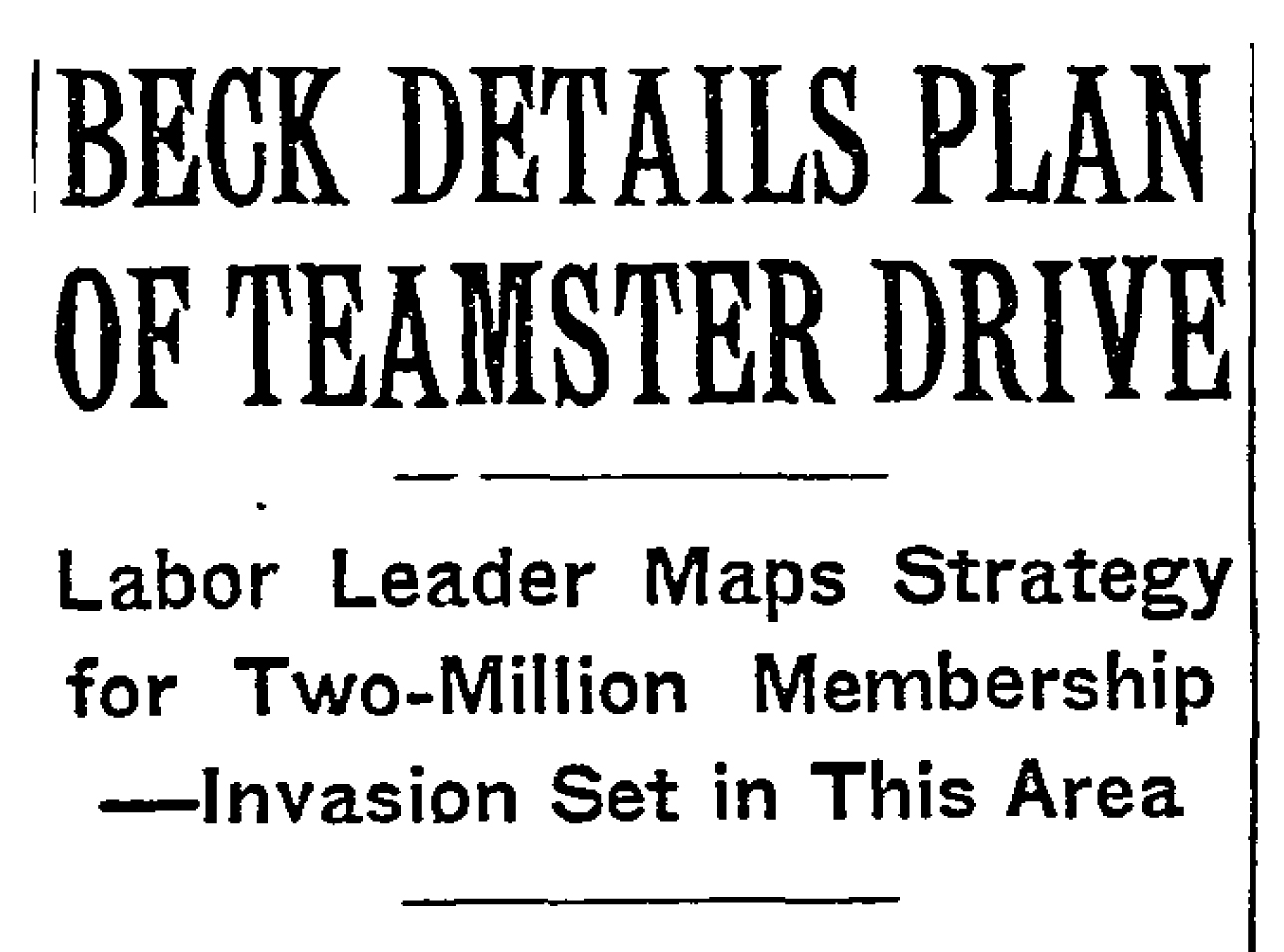 |
|
|
Local 804 ramped up new organizing at the end of the 1940's |
Teamsters set out to expand locally and nationally |
By the end of the decade, Local 804 had become the primary union of delivery and warehouse workers in the New York Metropolitan area, adding 230 Gimbels Dept. Store warehouse workers and 685 JC Pennys warehouse workers, as well as countless local department, furniture and drug store employees.
Part 4 – Teamsters on the Rise (1950's)
Many changes occurred in the U.S. during the 1950’s. Americans moved out to the suburbs in large numbers, creating a new “car culture” where consumers drove to shop. Even in cities, customers increasingly carried their own purchases. Additional challenges to American workers included increasing automation, changes in the patterns of production and distribution and a conservative political climate that spawned anti-union legislation.
But Teamsters, at both the local and national level, prepared to overcome these obstacles.Teamsters expanded organizing and created public relations campaigns. In addition to Local 804’s campaign to convince consumers to use members’ services, the Teamsters created a national decade-long campaign to “Have it delivered” promoting Teamster freight and delivery services. Also during this period, DRIVE (Democrat, Republican, Independent Voter Education) was created to increase Teamster political influence.
Congress approved the Federal-Aid Highway Act in 1956, which created the Interstate Highway System. Teamster leaders were key in helping pass this legislation. The creation of the Interstate Highway System greatly impacted on the American economy, producing new jobs in manufacturing, construction and transportation.
While still providing deliveries for retail stores, UPS also began expanding into freight. UPS’s specialized in parcel post – or small packages weighing a pound or more – and competed with the U.S. Postal Service. But In the early 1950’s the US Postal Services stopped delivering packages weighing over 20 pounds. During this period, UPS expanded and became a national company.
In preparation for a new decade, Local 804 moved from its West 42nd Street Manhattan offices to a new hall at 24-01 Jackson Avenue in Long Island City. The same year, 1949, significant changes were made to the Local’s bylaws. For the first time, stewards were elected directly by the membership and a formal Stewards’ Council was created. The terms of Local 804’s President, Vice-President, Secretary-Treasurer and Recording Secretary were extended from one to three years.
| Click on images to enlarge | ||
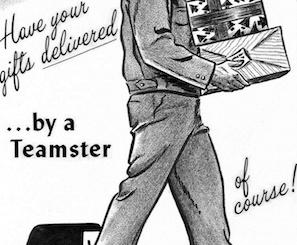 |
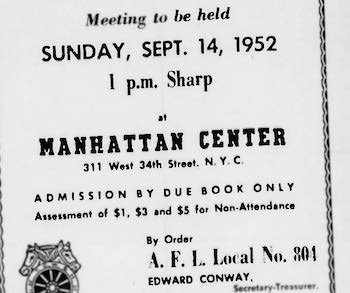 |
|
|
National Teamster Campaign |
General membership meeting notice – Note that members were fined for not attending union meetings. |
In the Community
As in earlier times, Local 804 actively supported important causes. In the early 1950’s the local participated in a push to raise funds for a polio cure. Once the vaccine was developed, Teamsters across the US helped to distribute it.
(photo, press release)
| Click on images to enlarge |
 |
|
Inspecting the 1951 polio poster are (L to R) Thomas Beaton, UPS Personnel Manager, |
In 1949, International Vice President Dave Beck spearheaded a major organizing drive to bring in an additional 2 million warehouse workers nationwide. Local 804 figured prominently in the plan. With the blessing and the financial support of the IBT, Local 804 stepped up organizing warehouse workers. The international also created regional conferences and industrial divisions with the goal of creating national and industry-wide contracts.
 |
| 1953 Organizing |
In the spring of 1950 Local 804 obtained strike authorizations from both Joint Council 16 and the IBT for actions at JC Penny, UPS, Macy’s warehouse, Peck & Peck and Winston Television. In a departure from the previous decade, Local 804 did not engage in wildcat strikes. The support of fellow Teamsters – including worker payments from the national strike fund – helped to strengthen the contracts of Local 804 members.
25 and Out Pension, Contract Gains
Local 804’s made significant contract gains over the decade. UPS members received a severance retirement plan that paid $3,000 - 5,000 if they worked until the age of 55. In the 1954 contract they received a weekly raise of $5.50, bringing up basic pay to $80 a week, as well as and shift differentials of up to 10 cents.
Three years later, Geiger negotiated a contract with a very unusual provision – a 25 years and out pension. Rather than receive a lump-sum payment at retirement, UPS workers retiring at age 55 with 25 years of service had the option of receiving a monthly pension of $141 a month until age 65. Once retirees reached 65, the monthly payment would drop to $33 per month, which, combined with social security payments, would equal $140. The new Local 804/UPS pension plan was considered the best pension plan for union members in the country.
At the time, most American workers had their pensions cut 35%-40% if they retired at age 55. Local 804 argued that for reasons of safety, drivers should be able to retire at 55. Safety studies had shown a correlation between advancing age and driving accidents. The new pension gave workers the incentive needed to retire while still relatively young and healthy.
| Click on images to enlarge | ||
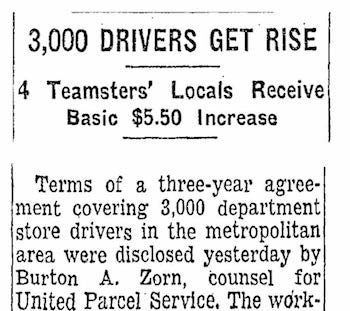 |
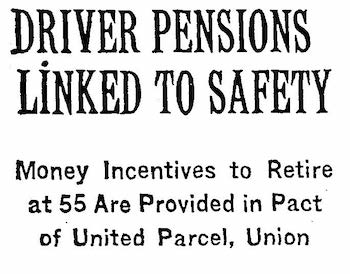 |
|
|
1954 UPS Contract Highlights |
25 and Out! |
|
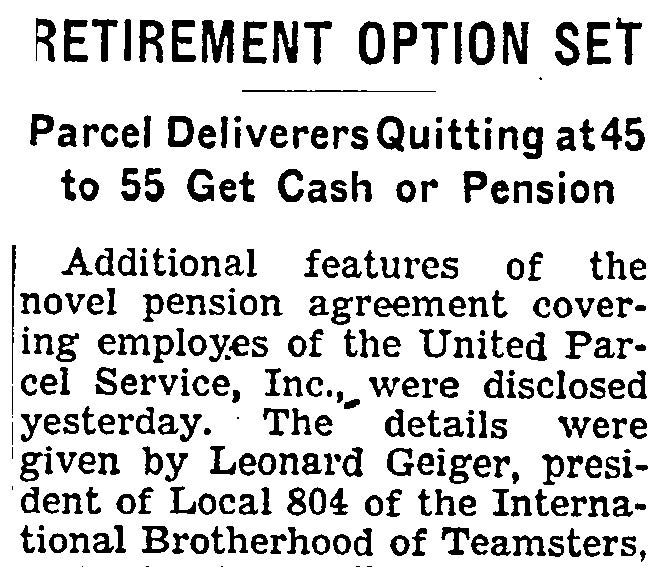 |
||
| First in the nation |
Changes in Retail and Labor
While conditions improved markedly for members employed at UPS, the Local had lost over 1,000 members by 1957, a result of the closure of several department store warehouses. The Local’s executive board called for a $1 a dues increase, up to $3 per month, to make up for the lost membership and higher assessments from the International union. But the membership overwhelmingly voted it down, despite the fact that the majority of area Teamsters paid dues of $4 - $5 a month.
 |
| Members vote down a 1957 dues increase |
Mid-decade, the AFL and CIO merged to form AFL-CIO, lessening the competition for organizing between the former rivals. However, many Teamster locals, including 804 continued to organize former CIO workers whose unions had gained jurisdiction within the AFL-CIO. Notably, Local 804 refused to honor a 1956 Macy’s sales staff strike. The following year, IBT Vice President James R. Hoffa announced a push on the East Coast to organize not only store warehouse workers, but also sales and office workers who were often represented by CIO unions.
| Click on images to enlarge | ||
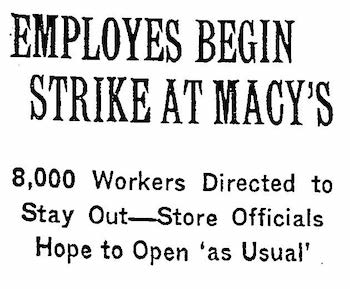 |
 |
|
|
804 did not honor a RWDSU strike |
Teamsters expand organizing |
Relations between the US Congress and Teamsters, as well as between the AFL-CIO and IBT, were rocky. At the national and local levels a split occurred within the Teamsters as well. Running for General President were James R. Hoffa and Thomas Hickey. Local 804 President Geiger strongly supported Hoffa, will many Local 804 members backed Hickey.
In 1957, the US Senate Select Committee on the Improper Activities in the Labor or Management Field – also known as the McClellan Committee - subpoenaed several Teamsters, including Local 804 Pres. Geiger, to testify on an attempt to seat “paper locals” within Joint Council 16. The US Marshall was unable to locate Geiger for a month, until he was declared dead from a heart attack at a New York hospital.
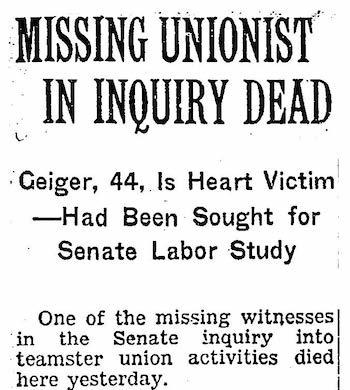 |
| Local 804 Pres. Geiger dies |
The death of Teamster Local 804 President Leonard Geiger in August 1957 opened up a period of strife within the local and throughout the Teamsters.
Jack Mahoney was elected President of Local 804 and James R. Hoffa was elected General President of the IBT. Also in 1957, the Teamsters were expelled from the AFl-CIO for refusing to make “reforms” or remove James Hoffa as General President. In the year after Geiger’s death, Local 804 engaged in 20 wildcat strikes.
The UPS contract negotiations of 1959 were contentious. For the first time in more than a decade, Locals 804, 138, 177 and 478 struck. The unions however, had less leverage than in 1946. UPS’s volume had decreased 23% since 1951. The bulk of UPS work was delivering for stores, and fewer customers were having their packages delivered. As reported by the New York Times, a division within Local 804 complicated negotiations. One faction was headed by President Mahoney and the other by Secretary-Treasurer Conway. New York Times labor reporter A.H. Raskin wrote that, “rank-and-file democracy had been carried to such lengths as to approach anarchy,” and that 37 men (804 members) took part in negotiations, with each having a different idea of what should be in the final contract.
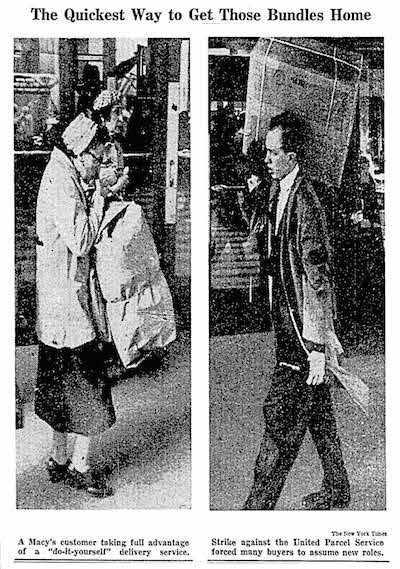 |
| Coverage of the 1959 UPS strike |
Public opinion appeared to have soured on the strikers. Raskin wrote that the fear of being labeled “sellouts” led Local 804 officers to hold out for unrealistic and unattainable demands that threatened the solvency of UPS. He noted that the union’s noneconomic demands included giving the union veto power on the company’s rights to open new depots. He also reported on the union’s rejection of a clause they had put forward after the company had agreed to it.
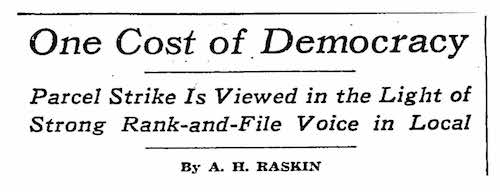 |
| A piece by The New York Times labor reporter. |
Retailers, including Macy’s filed NLRB charges against the Locals for engaging in secondary pickets in front of their stores. Joint Council 16 opposed those pickets. Local 804 no longer had the full support of the Joint Council and International union in contract negations and actions.
Part 5 – A New Leader for the ‘60s
The new decade brought changes to the labor movement and America as a whole. The baby boom generation, including more women, was entering the workforce. The civil rights movement was taking hold and the demographics of the Local 804 membership was also changing. By decades end, almost a third of Local 804 members were African American.
There was also a growing recognition of the need to help workers and their families with mental health and substance abuse problems. In 1962, Local 804 helped found Teamsters Center Services, which still provides confidential services to Local 804 members.
UPS continued its expansion. In 1960, the New York Public Service Commission granted permission for UPS-New York to expand and operate a statewide delivery service for commercial and industrial companies. UPS estimated they would employ another 300 workers with an additional 272 trucks.
Jack Mahoney, elected Local 804 President in 1958, served only one term. Vice President Thomas Simcox followed and was first elected Local President in 1962.
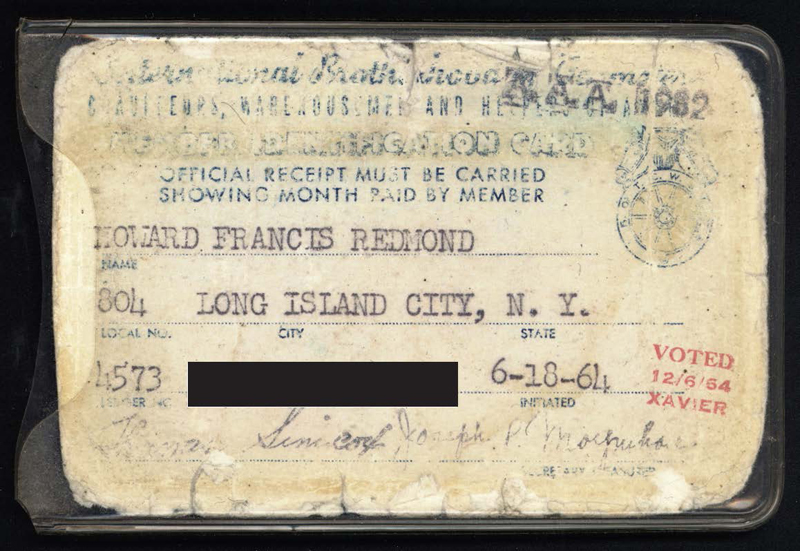 |
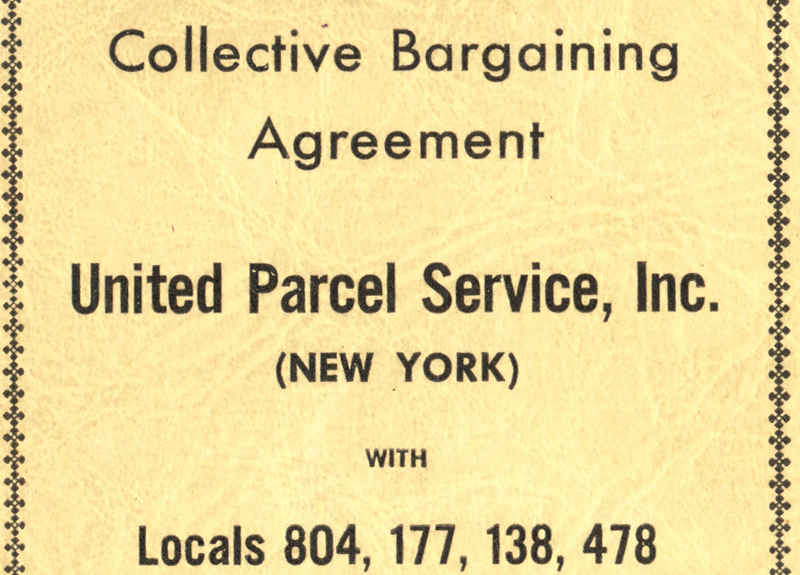 |
| 1960s Union Card | 1962 Contract Book |
The media reported on increasing dissent within labor unions. An unnamed labor lawyer told the New York Times in 1962 that there was a growing gap between the labor leaders and rank and file members, a deterioration in leadership resulting from the Senate Select Committee on Improper Activities in the Labor or Management Field and the LMRDA of 1959, as well as “many workers have(ing) become union members only by virtue of union shop. They know pathetically little or what it is all about. Their basic attitude is ‘gimme’.”
The Militant newspaper declared “United Parcel Strike in N.Y. Illustrates New Union Mood.” One month earlier, Local 804 UPS drivers struck after rejecting a contract that was endorsed by Local 804 leadership and International Union. The Local and IBT did support the strike, however, and provided members with support and strike benefits. The central issue of the strike was management’s demand for a “speed-up” clause and members believed the proposal gave the company “unrestricted flexibility” which threatened job security. The contract also allowed UPS to hire part-time workers for evening shifts. The strike ended 7 weeks later, though members accepted the exact terms that they had previously rejected.
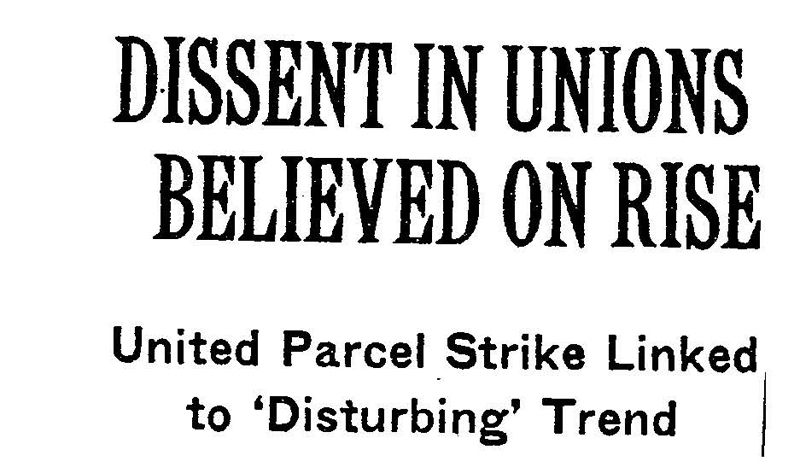 |
||
| Militant 1962 | Dissent in Unions |
Almost 600 Long Island City Macy’s warehouse workers also struck in the summer of 1962. It lasted for six weeks. They had greater success and won a contract that raised weekly wages 6 to 8 dollars a week, along with fringe benefits.
Numerous wildcat strikes would occur throughout the 60’s. But Local 804 also worked with employers when it benefited workers. For example, in 1963 the union mobilized members to oppose Mayor Wagner’s proposed sales tax increase.
In 1964, the first National Master Freight Agreement was signed. It was a turning point for the Teamsters, the first step in a larger dream to nationalize union contracts and create a single, higher standard for all workers. The first UPS national agreement would not be negotiated until the 1970’s.
In 1965, a UPS contract was reached without a strike “for the first time 12 years,” according to Local 804 President Simcox. The contract, covering drivers, deliverymen and inside workers, brought the average weekly wage to $134.80, made improvements to the pension and health funds, as well as three paid sick days.
Despite the success of the 1965 contract, internal dissention remained at the Local and members were ready to elect a new generation of leaders.
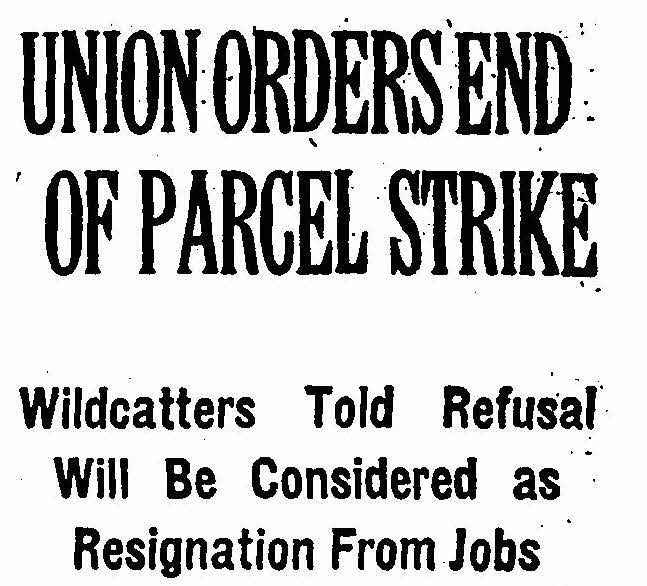 |
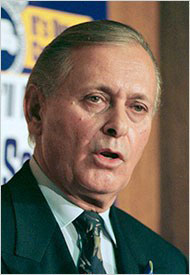 |
| 1966 Wildact Strike | Ron Carey |
In late 1967, the “Security and Future” slate, headed by Ron Carey, was elected to lead the union. Central to the slates platform was a $250 monthly pension after 25 years (regardless of age), increased welfare fund and fewer strikes. After losing the election, former Local 804 President Simcox was appointed President of Joint Council 16 by the IBT.
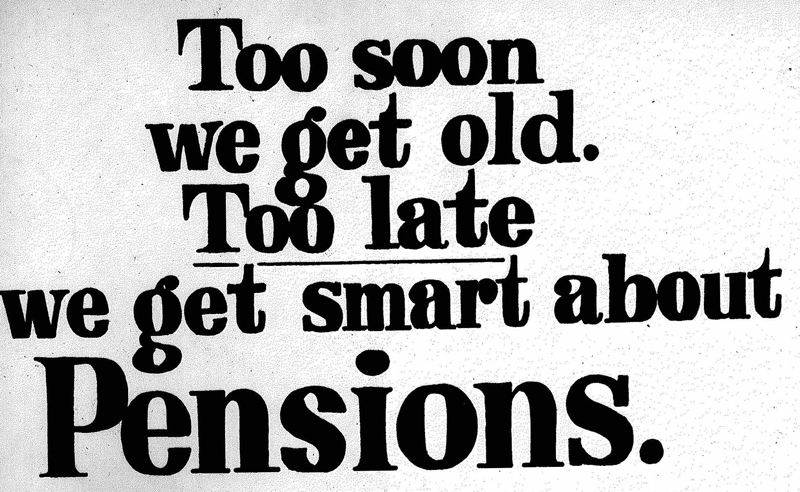 |
 |
|
| Security slate | Who wins a strike |
Despite leaderships pledge to resist striking, Local 804 UPS members went on strike in May 1968. President Carey said that the main points of contention were stopping the company from increasing the number of student part-timers hired (they were not union members) and the company’s increased use of rail for long-haul operations.
Two months into the strike, acting Teamster General President Frank Fitzimmons overrode Local 804 leadership and scheduled a membership contract vote. A few days later, Teamster Locals 804, 177 and 138 announced a tentative agreement and scheduled a vote. The New York Times reported that numerous members and shop stewards booed during the contract and called for members to vote the proposal down. The contract failed to deliver the $1 an hour raise the union had fought for, as well as an end to the company’s use of “piggyback runs” – transporting trucks on railroads.
However, the tentative agreement did include many improvements. It provided raises and increases to health and welfare benefits and created a member dental plan for the first time. While a $250 monthly pension, regardless of age, was not achieved for members with 25 years of service, it was for members with 30 years of service (and to those with 25 years of service aged 55). They would now receive a $250 monthly pension until age 65, at which time the payment would drop to $120. Members with less time in (or a lower age) received a smaller pension. While the contract did not end the use of student part-time workers, UPS agreed to not increase the hiring of part-time workers.
| Tentative Agreement | Mechanics Ratify Parcel Contract |
Local 804 members approved the contract. But as they prepared to return to their jobs, UPS mechanics, represented by IAM Local 447 mechanics, voted a contract down whose terms were very similar to the Teamster contract. The mechanics had honored the Local 804 pickets, but when they called for their own strike, Local 804 ordered their members to cross the IAM picket lines. Despite the lack of support from Local 804, within a couple of days, the mechanics voted for a contract deal that raised wages higher than the first offer.
Part 6 – 1970’s - Old Glory & Black Liberation; Local 804 Scholarship Fund
In its eight-decade history, Local 804 often struck over working conditions, but the cause of the 11-day strike in 1970 was unusual. Local 804 called a wildcat strike over UPS’s refusal to allow package drivers to wear lapel pins on their uniforms. With controversy over the Vietnam war raging, UPS workers, many of whom were military vets, wore patriotic pins. UPS did not object. However, an estimated 35% of UPS workers in the NY Metro area were African American and some of these members displayed black liberation buttons. Still others declared their political beliefs with anti-war buttons. At that point, UPS forbade workers to wear pins of any kind on the job.
An arbitrator ruled in favor of the company and fined the union. Local 804 President Carey, a Nixon supporter, declared, “We are striking for the American flag and the pride of a man in his country or his race.” In the end, UPS agreed to allow workers to wear flag lapel pins but no others and members returned to work.
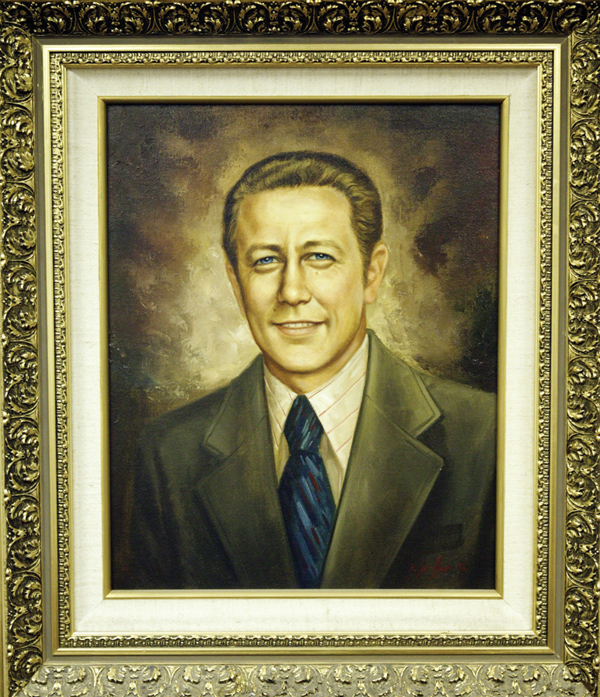 |
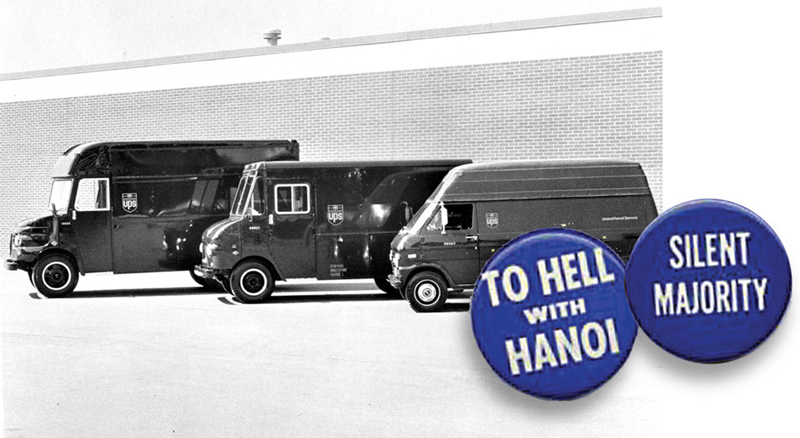 |
|
| Edward Dougerty died while picketing in 1974. | UPS Fleet, 1970, (right) Lapel pins in support of the Vietnam War |
The cause of the next UPS strike, in 1974, was a break down in contract negotiations. UPS was seeking to replace full-time workers with part-time sorters. The strike began on August 24th. Rubin Tollincho, a Maspeth UPS worker, told a New York Times reporter, “that because of the strike, he had postponed his marriage indefinitely, sold his car, given up his apartment and moved in with his mother.”
Local 177 in New Jersey was no longer bargaining jointly with Local 804 and Local 804 believed that New York work was being diverted to the Local 177 represented Secaucus facilities. In protest, Local 804 set up pickets in New Jersey.
Tragically, on August 29, 1974, Local 804 Trustee Edward “Doc” Dougherty was killed by a UPS truck while picketing outside the Secaucus UPS facility. No charges were brought against the driver, a Local 177 member. To honor his memory, Local 804 created the Dougherty Memorial Scholarship Fund.
During the strike, UPS was in the process of moving its headquarters from Manhattan to Greenwich, Connecticut. UPS claimed losses in its New York operations and threatened to shut them down. Having closed operations in Philadelphia several years earlier, this was not an idle threat. On November 21st a compromise was reached. The company won the right to replace full-time workers through attrition, but was limited to 180 new part-time positions per year. Wages were raised and members won cost of living increases.
For the first time, a national UPS contract was negotiated in 1979. The Local 804 leadership, which had operated largely independently of the national union for the previous decade, resisted inclusion in a national contract.
In addition to establishing a Local scholarship fund, the union also created a credit union. The idea to form a credit union for union members was initiated at a Local 804 IBT union meeting by Local 804 President Ron Carey in 1978. It came to light in the early 70’s that many 804 IBT members had a great need to accumulate savings and have access to affordable credit. With the buy-in of the Board, they were granted a charter for Local 804 Federal Credit Union that year.
The mission of the credit union was and remains: To provide quality financial products aimed to enhance the well-being and quality of life of our membership through encouraged thrift, savings, and the wise use of credit.
The 1980’s and 1990 were a time of great changes for Local 804 members, for Teamsters nationally and for UPS. These events continue to impact Local 804 members. Significant events, included working under a National UPS agreement, as well as a Local supplement and the first nationwide UPS strike. The end of the 1990’s brought changes to UPS’s corporate structure and the advent of e-commerce.
Nationally, deregulation, coupled with a conservative political climate seriously weakened the position of organized labor. By the 1990’s Teamsters membership was half the size of the 1970’s.
Into the early 1980’s, department stores were still a major UPS customer. A 1982 UPS walkout caused panic at New York stores. But the strike only lasted a couple of days. Because the action violated the no-strike clause, the company was granted a federal restraining order.
Through the 1980’s, UPS National Agreements were ratified by slim majorities. The 1990 contract, in addition to raising wages, increased contributions for health benefits and pensions from $8,300 a year to $10,500. It also called for improvements in working conditions.
Leadership Changes
In 1988, Local 804 Secretary Treasurer John Long, who first elected in 1968, was charged with receiving kickbacks on union pension investments and was found guilty. Though the verdict was later overturned, Long was permanently banned from holding Teamster membership, under the authority of the Independent Review Board (IRB). The IRB was established by the Consent Decree between the IBT and U.S. government in 1989.
In 1991, Local 804 President Ron Carey was elected General President of the IBT. It was the Teamsters’ first direct election. He served as President for both Local 804 and the IBT. Carey is best known for successfully leading the first national UPS strike in 1997. See Part 8 “1997 UPS Strike – 20th Anniversary”.
Carey was re-elected General President in 1996, but that election was later voided because of a campaign money laundering scheme. James P. Hoffa won the 1998 re-run election and the IRB subsequently expelled Carey from Teamster membership because of the 1996 campaign violations. Local 804 Secretary-Treasurer Howard Redmond became the next Local 804 President.
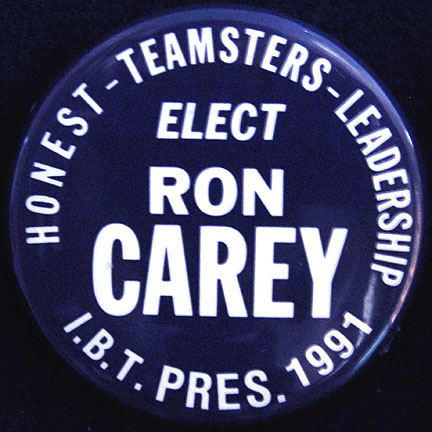 |
 |
| Ron Carey was the first directly elected Teamster President | Howard Redmond Succeeded Carey as Local 804 President. |
UPS IPO
After a century as a privately held company, UPS sold its first public stock shares in 1999. Until then, workers, managers and executives held company shares. Though not a majority, 66,000 UPS shares were held by Teamster members, who were fist permitted to buy company stock in 1995. It was supervisors and upper management, who had been able to purchase shares since 1927, who gained the most. Stock prices surged during the Initial Public Offering (IPO) because investors believed that the company would grow with the rise of consumer Internet shopping.
With the largest private sector union contract in the country, then, as now, all eyes are on UPS –Teamsters contract negotiations. Two decades ago, faced with unreasonable company demands, Local 804 members and Teamsters across the U.S. voted overwhelmingly to strike.
On August 4, 1997, 187,000 UPS Teamsters hit the picket lines. Among them was Local 804 member Pablo Ramirez, who was then a package driver in Maspeth. Ramirez recalls, “It was a tough time, but we were fighting for something that mattered. We were united and stuck together during the strike.”
It was the first and only national UPS strike. Over the 15-day strike, losses for UPS were estimated at $780 million. Only 20 percent of deliveries were made over the course of the strike.
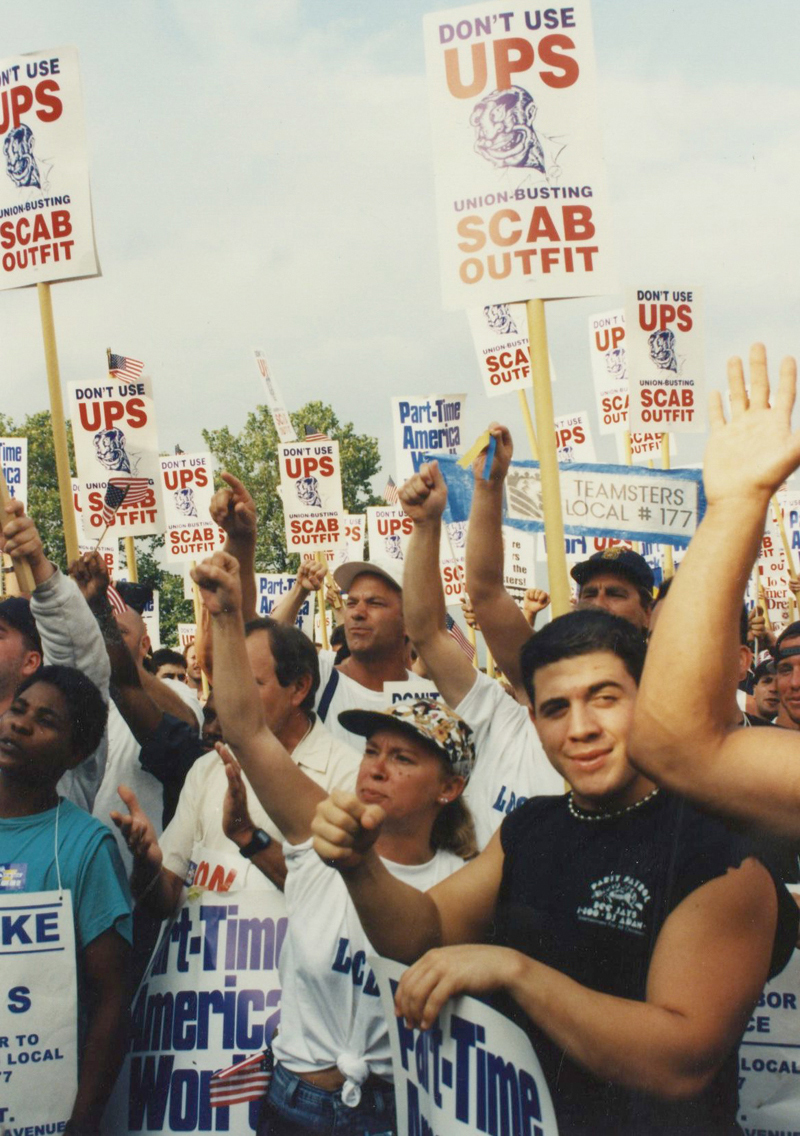 |
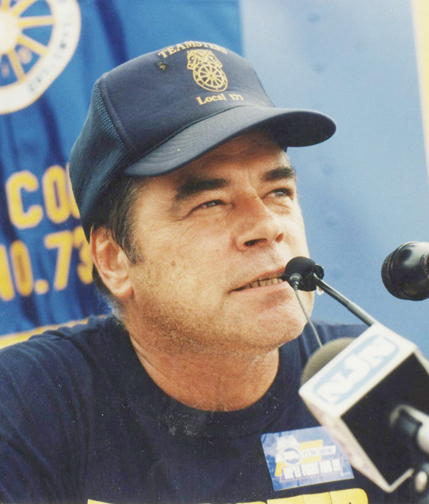 |
|
| Teamsters Rally. | A LU 177 Member Speaks, 1997. |
The union’s top demands were maintaining joint control of the pension and the creation of more full-time jobs. The company wanted to take over the pension funds, increase contracting out and add more part-time jobs. Months of negotiations yielded no agreement.
With President Ron Carey leading both Local 804 and the IBT, New York Teamsters were front and center in the struggle. The high profile strike galvanized the entire labor movement and the public.
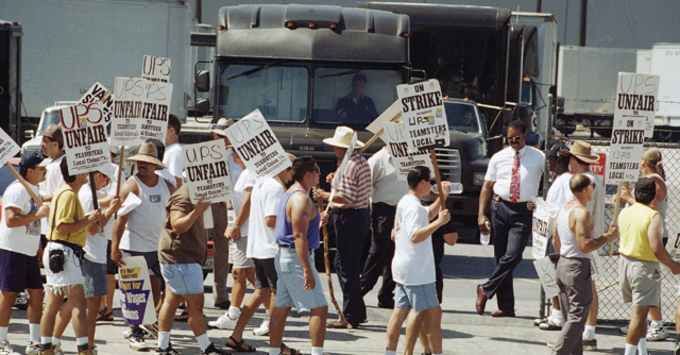 |
 |
|
|
On the strike line. |
Ron Carey was both Local 804 President and IBT General President at the time of the strike. |
Teamsters, of course, won the strike. The Teamster-UPS pension funds remained in place and UPS agreed to create 10,000 full-time jobs over the course of the five-year contract. But it was also a victory for all workers. We showed that when workers stood together they could win.
 |
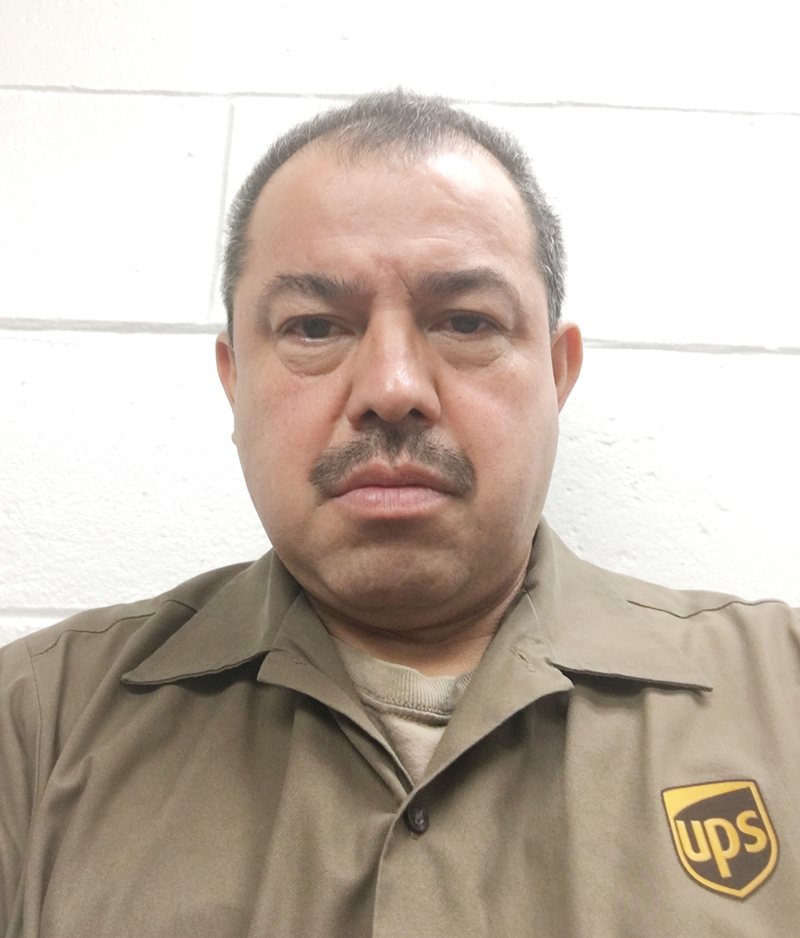 |
|
| Local UPS Driver Pablo Ramirez (left) shown in a 1997 news story. | Pablo Ramirez 2017 |
Pablo Ramirez is still a package driver, though he now works out of Long Island City. Ramirez said, "In unity is strength. People have made great sacrifices for what we enjoy today and it’s our job to keep it for future workers.” He plans to begin enjoying his retirement in the next couple of years.
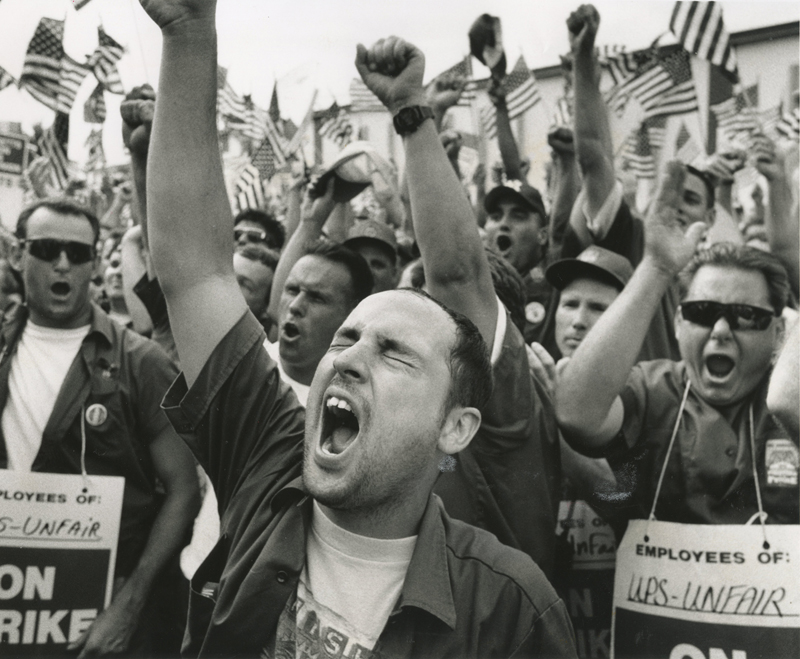 |
 |
|
| UPS Strike Rally, August 8, 1997. | UPS leafleting |



